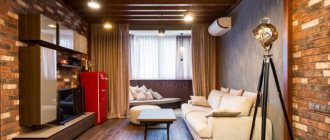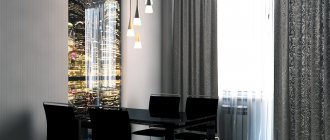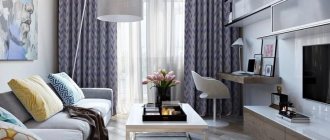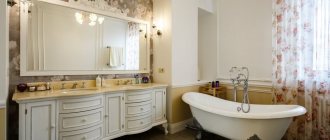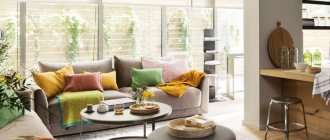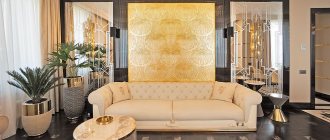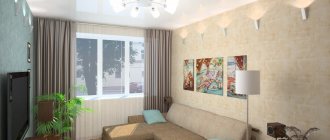Style, like in a fairy tale in reality. Noble, luxurious, gentle, romantic and cozy. The Arabian interior amazes with its beauty and charm. Of all the oriental interiors, this one has always been singled out. And when they talk about the exquisite interiors of the East, they mean the Arabic direction. It combines national ornaments, expensive fabrics, and elegant hand-made details. All this makes the environment comfortable and relaxing.
Features of the Arabic style
- Arabic design stands out from others due to its religious component. The Holy Quran prohibits the presence of sculptures and picturesque images of people and animals in the design of a home. Therefore, when decorating premises, mosaic graphics, patterns of geometric lines and shapes, exquisite and complex ornaments are used, and floral themes are successfully used.
- The panels on the walls are made in square, diamond or hexagonal shapes, even the carpets and floor tiles are decorated with combinations of geometric shapes. The room must have a clearly marked and decorated center.
- The most popular architectural forms of the Arabic style are the sphere and the semicircle, combined into complex structures, resulting in exquisite arches and majestic window openings.
- By tradition, the oriental style does not imply the presence of familiar doors. The space is delimited by curtains, arches and semi-arches, colonnades. Arabic design implies a certain privacy, so it does not have the trendy European open floor plans.
Design of window and door openings
It is difficult, and most often simply impossible, to replace the wide window of a modern apartment with a narrow and lancet one, as in the houses of the East. But you can narrow it down with curtains that form a pointed arch.
Instead of doors, in the East they use carpets, covering the doorway with them. In a modern apartment, it is enough to hang heavy curtains.
Yes, the style is complex, requiring large investments, both material and moral. But the result will shock both the hosts and the guests.
Decoration Materials
▫ The ceiling is decorated with paintings, multi-stage structures or decorative panels. Coffered ceilings, multi-level with lighting or suspended mosaic coverings are successfully used.
▫ The walls are painted or wallpapered. When painting, one color is used or intricate oriental script is applied to wet plaster. The wallpaper should have a geometric or floral pattern or fabric imitation. ▫ Floors are usually finished with tiles or mosaics. The tile size is usually small, 10x10 cm, or less. ▫ Wood is used to decorate window and door openings. Timber frames, shutters and grilles add a special accent to the room. To live in a house decorated in a truly Arabian style, you need to have a special worldview. The East is bliss, a calm rhythm of life, comfort, the slow passage of time, which is hardly possible in the modern world. Therefore, the Arabic style in the interior requires a respectful and careful attitude, the introduction of certain philosophical and religious traditions and rituals into life.
Handmade decorative items
Hardworking slaves, brought by Arabs from distant countries, tirelessly weaved beautiful carpets, sculpted and painted dishes, and inlaid furniture with wooden or bone mosaics.
All these items were intended to decorate the palaces and houses of wealthy padishahs and their entourage. Over time, they became an integral part of the Arabic style.
Today it is difficult to buy a handmade carpet, so it is replaced with high-quality imitation. Well, the tradition of decorating furniture with mosaics and placing dishes, vases, and jugs in prominent places has been preserved. You can place a hookah on a podium with pillows, and place a cage with a bird on the windowsill.
Lighting
The Arabic style interior is characterized by rich lighting: large wrought iron chandeliers, various lamps, wall and table lamps, sconces, candelabra. All light sources have a complex design and emit a mysterious golden glow, which adds richness to the color of draperies and interior fabrics. Dim, diffused light provides an intimate and relaxing interior atmosphere. Aroma lamps with oriental spices fill the air in the room with sweet aromas.
Modern design of hamam or Turkish sauna
All photos In the photo: Interior design of a Turkish hammam in Grozny
So, in the living room and hall you will be greeted by bright upholstered furniture and ornaments on carpets and pillows, but how do these signs of oriental style manifest themselves in the design of a traditional hammam?
Ornaments here are used in the design of walls and floors with mosaics; rich colors can be bright inserts or large accent walls. In addition, the decoration of the hammam often uses fancy arched vaults, like mosques and other public buildings in Eastern countries.
Oriental style and art deco in the interior of the relaxation area in front of the hammam
All photos In the photo: Interior design of a Turkish hammam in Grozny
The interior of this recreation area was designed by our designers from the studio of Angelika Prudnikova. The hammam here has stunning glass walls and doors, allowing you to enjoy the designer lighting inside even from the relaxation area. Lighting and lamps in ethnic format are as important elements of an oriental-style design project as any other. She always gets due attention!
With a hammam, a swimming pool and a relaxation area, it would be nice to build a terrace in an oriental style, which with its color would maintain an atmosphere of relaxation and rest, like in a Turkish resort. In any recreation area of this type, there is an opportunity to put a refrigerator with soft drinks or a whole bar, because the warm climate makes its own adjustments to the lifestyle. In addition, the recreation room can become a place to play board games, such as traditional backgammon!
Shades of gold in the interior of a Turkish hammam
All photos In the photo: Luxurious hammam with gilded mosaics in the interior
The design of a hammam is usually based on the specific purpose of the room and centuries-old cultural traditions. Mosaics are used for decorative finishing. There are mosaic panels, lighting, unusual decorative inserts (for example, with gilding), and metal ethnic lamps. An important part of the hammam is the round dome, which gives this room a special mood. A qurna, a shell-shaped marble vessel intended for ablution, is always accented in the interior with a pedestal or arch with lighting and a mosaic pattern.
This small hammam is designed for 4-5 people, large - for 10-15 people. If you are planning family use, it is best to choose the first option in a country house, and the second if you want to invite guests and relatives.
Decorative niche with lighting in the shape of a mosque dome
All photos In the photo: Decorating mosaic walls in the hammam
Thanks to the rapprochement between Russia and Turkey in the tourism and economic aspects, the Turkish style in interior design is becoming popular today. Turkish interiors are usually more modern than Arabic ones, since this country has long been part of the European community. The Turkish style has less gilding, luxury and more influence from France, the Mediterranean countries and Great Britain in design and decoration. Therefore, a restrained palette of shades is more common here than bright colors, as in the Indian style, for example.
At the same time, in the interior of a living room and bedroom in a Turkish style, plain beige walls (rather than painted or with decorative wallpaper) and upholstered furniture of the European type are more often used. All these nuances make the interior English-style aristocratic and orientally cozy. So, if you don’t like bright colors, you can easily afford an interior design in an oriental Arabic style without them!
Luxurious decoration of a Turkish hammam in blue tones
All photos In the photo: Interior design of a Turkish hammam
This hammam design project is made in darker colors with decorative blue lighting with neon ribbons. In the center is a traditional hamam coffee table. In small rooms it is intended for drinks, and in large ones there is also a massage podium, decorated with marble or mosaic, but usually it is still located in another room - between the hammam and the relaxation room.
The decorative finishing of a vaulted ceiling is a very important part of the entire design project. No less important is the format of lighting, which, thanks to modern lamps, can be made in various shades (in the original these were shades made of colored glass).
Stunning hammam design project with mosaic the color of the night sky
All photos In the photo: Hammam interior design by Angelika Prudnikova
The dark finish of the benches and light mother-of-pearl mosaic in the interior of this hammam looks incredibly charming. You enter such a room as if you are entering another world, and you completely surrender to the atmosphere of idyll and tranquility. This is exactly the effect that an interior designer achieves by choosing the Eastern Turkish style for the design of the hammam and relaxation areas.
You can find out prices for the design of hammam and interiors in oriental style from Anzhelika Prudnikova here. You can see our studio's full portfolio of projects here. If you like hammam, you shouldn’t deny yourself this pleasure, because any sauna, including the Turkish one, turns your home into your personal spa resort!
Traditional hammam with benches decorated with malachite marble
All photos In the photo: Hammam interior design from our studio
This stunning hammam impresses with the finishing of the benches with green marble and blue mosaics, the luxurious effect of the night sky on the vaulted ceiling and the mirror finish of one of the walls. These are the hammams that can now be found in boutique hotels in Turkey, in luxurious Turkish villas in Istanbul, in 5* hotels!
Hamam is such an important element of Eastern culture that its appearance is an image of the traditional way of life. In Turkey and other countries, hammams are most often public; in ancient times, it was here that negotiations were held and business deals were concluded. Thanks to them, the entire city community felt like one.
The jugs in the hammam are designed for aromatic oils, with them every procedure and every evening acquires a special spicy shade. There are unique and especially expensive oils for holidays and traditional ones, for example, for every day with the wonderful aroma of rose petals.
Golden elements in the design of a Turkish hamam
All photos In the photo: Hammam interior design
Gilding is one of those oriental style design techniques that cannot be overlooked. It can be present almost everywhere - in finishing materials, furniture, decor, dishes, lamps, textiles, plumbing and fittings!
Arabic style furniture
In the Arabic interior there is not much furniture familiar to the “European”. Instead of chairs, for example, pillows are used. Armchairs, sofas, and ottomans must be covered with colorful satin bedspreads.
Interior items are made of hard wood and decorated with carvings and inlays. Among them are necessarily present: - A low sofa with a spacious sleeping area; — Ottoman; — Low cabinets with small capacity; — Many bedside tables of various shapes, often decorated with carvings.
Main features of the style
This style does not allow for uncluttered surfaces - absolutely everything is decorated with a pattern.
It is not permissible to place paintings depicting plants, people, or animals in the house.
The painting is a strange, outlandish pattern, which consists of various kinds of phrases of the Holy Quran, and is decorated with ornaments.
The highlight of the pattern used is the clarity of the lines with a description of each detail. Arabesque is made in bright and rich colors, for example, black, scarlet, emerald, crimson.
Textile
The textile design is indicated by an abundance of seat cushions scattered on the floor. Their designs and colors vary, but the most popular are those decorated with oriental patterns and stripes.
Curtains are made from expensive fabrics: silk, organza, velvet: burgundy, blue, gold, green. Carpets are a necessary decorative element. They cover the floor, walls, sofas, lay them out on top of each other, spread them out or hang them on any free surface. Preference is given to red, gold and yellow colors.
Traditions of ancestors
Arab tribes led a nomadic lifestyle. In the interior, this can be reflected with an improvised tent, carpets covering the floor and numerous pillows of different types, sizes and colors.
The curtains on the window should be with an oriental pattern, bright. There is a lot of fabric and it is gathered into folds and tied at the bottom with a cord, forming a pointed arch. The upper part of a wide window opening can be decorated with lambrequins.
In the bedroom, above the bed, you can make a canopy in the form of a tent made of silk or heavier dense fabric in green, turquoise or burgundy colors with trim around the edges in the form of a gilded pattern. In the living room it can be built above a sofa or ottoman.
Accessories
What needs to be added to the design of the room to recreate the Arabian image in it? • Lamps. They are located on the walls, on tables, and descend from the ceiling. Manufacturing material – colored glass, openwork metal.
• Dishes. Ceramics, metal - sets for water and wine, hookahs, and vessels for washing hands are made from these materials. They are usually decorated with inlay and painting. • You can advantageously emphasize the sophistication of the room by using vases, vessels, copper trays, hookahs, musical instruments, chess, richly bound books, wood and wrought iron products.
Kitchen space
A kitchen decorated in this style is the most fashionable modern solution for a country house.
The tiles are suitable for decorating both floors and wall surfaces. This design option is applicable only if the kitchen is spacious, well lit with natural light.
